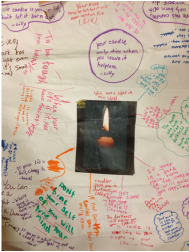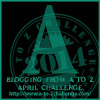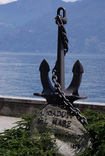
1. Japanese Fans
2. The Crafty Classroom Blog - several different types of fans
3. Japanese fan making for older kids
4. Pinterest - fun fans!
 The artifact for the day is Fantastical Fans. Not fanatical fans at a rock concert, but the beautiful handheld fans created to cool one's body. you can visit Wikipedia to discover the earliest archaeological finds of fans dating back to Greece at or before the 4th century B.C. and East Asia by the 2nd Century B.C. I lived in Japan for four years while my dad served in the U.S. Air Force. Everyone had fans - beautifully painted fans. I didn't know of stories that included these fans until I was an adult. One of my favorite stories that I tell to young children is from the book Twice Upon a Time by Judy Sierra and Robert Kaminski titled "The Tengu's Magic Nose Fan." I've included a youtube telling of this tale below. Another wonderful story is The Magic Fan by Keith Baker. I love every book Keith writes and illustrates! In this book Yoshi is a young inventor who discovers this fantastical fan that illustrates imagination. This fan inspires Yoshi to build a kite. He loses the kite but only then realizes it's his imagination that will continue his journeys in life! Activities: Wouldn't it be fun for the kids to create their own fans after listening to your stories? They would love it! You could use the traditional accordian folding of paper once they have drawn or painted a scene - no sticks needed. Or you could pass out popcicle sticks to be glued onto the back of the fan created. Here's some website ideas to springboard from: 1. Japanese Fans 2. The Crafty Classroom Blog - several different types of fans 3. Japanese fan making for older kids 4. Pinterest - fun fans! I leave you today with a wonderful storytelling one man/woman comedy show called Rakugo. These storytellers are only allowed to use a paper fan and a small cloth. It was only because of this A to Z Challenge that I learned about this type of storytelling! I LOVE IT!!! I can't wait to share it with my students. Please check out this blog and youtube: Derivejapan Blog
7 Comments
 Today's artifact is a bit of a stretch but I got the "E" in Epitaphs on tombstones. I know that epitaphs alone aren't artifacts but walking around older cemeteries and reading the epitaphs on the tombstones date back to the 1600's is pretty interesting. There's a life's story in just a few words - pretty impressive. Hmmm, I'm wondering what mine would say? Summing up one's life in a few sentences takes some practice. Wouldn't it be cool to either begin or end a story with our character's epitaph. I'm not sure if I've ever heard anyone tell a story beginning or ending with a summary of a person's life. I think this would be effective if my students were to storytell an event in a historical character's life, like Daniel Boone, Davy Crockett, Marie Curie, or Helen Keller and personalize it with an epitaph in poetry form depicting the character traits of that person. A fun writing activity would be to write poetry epitaphs for historical people studied in history and science. The students could work in groups, research the historical figure, agree on this person's character traits and create an epitaph - funny or serious.
I've included some fun websites that give us insight into funny epitaphs and further writing activities: How to Write a Funny Epitaph Grave Humor Famous Epitaphs  Dollars and dimes are artifacts that certainly won't buy today what it has in the past. We should share this fact with our young storytellers, writers, and readers through discussions, research, and of course stories that are situated in the past and present. Storytelling becomes more vivid when the setting is authentic. A bit of research may be necessary when telling a historical tale that dates back older than we are. Speaking to experts, such as older relatives, friends, and neighbors who remember what they bought for a "buck" would be beneficial to enriching any story from the past. Asking the right questions could easily refresh memories of old. Guiding statements and questions: 1. I took a dime and a dollar to the grocery store yesterday and I couldn't find a single item I could buy. Has it always been that way? Was there a time when you bought items with a dollar or a dime? What were they? 2. What type of entertainment could you buy with a small amount of money? (movies, amusement rides, bowling) 3. Have you heard of these sayings before? *"Brother, can you spare a dime?" *"A dime a dozen" What do these sayings mean to you? Here's a few fun facts I found on the internet: 1 cow cost $10.00 in 1800 1 chest of drawers cost $2.00 in 1802 a moderate home cost $1,980 in the 1920's peaches were sold for .10 a dozen in 1866 in Galveston, TX Think about the setting of the story you are working on. What was going on economically during the time period of your tale? How can this impact your characters? Visit your library or reputable websites and find out the costs of entertainment, food, shelter, toys, and transportation and enrich your story with some of these facts if possible. Your listeners will sip the flavor of the time period through your story!  My candle burns at both ends; It will not last the night; But ah, my foes, and oh, my friends-- It gives a lovely light! by Edna St. Vincent Millay Source: Poetry (June 1918). There's nothing better than the atmosphere of scented candles lit, dancing flames, and the gathering of stories told around its flickering shadows. A quick write revealed a few glimpses of holding short, fat white candles with a cut out circular cardboard base to catch the wax during our Christmas Eve Church services, and lighting of candles during my wedding ceremony. Candles were the source of light from darkness throughout history and have come to symbolize hope, clarity, warmth, and love.  Chalk talk activity: Storytelling Club a few years ago, we dug deep to discover truisms from an image posted on chart paper (6 tables, 6 chart papers, 6 different images). Students were placed in 6 groups and asked to walk around the tables and post their thoughts based on the image. No talking allowed at this point (hard for them). I did have Mozart playing quietly in the background. The kids were allowed to revisit the tables at any time, read what was posted, and add any connections. I was amazed! From here, came stories with light, personal tales, and poems. A few stories incorporating the artifact of candles that have impacted me as a storyteller are:
The Candles by Hans Christian Anderson The Hodja tale: The Flame of a Candle, retold by Marci Stillerman The Crimson Candle by Ambrose Bierce books are the artifacts for today: 3 Mentor texts to engage young and old storytellers alike4/2/2014  You know a great book when you read one. I'll mention three fantastic books that have engaged 2nd graders on up to adults to write creatively, share their stories with each other, and then perform their polished tales to eager listeners. Please reply with other titles that you would like to add to this growing list. These three books act as mentor texts to engage students in reading, writing their own versions, and then performing these tales through the craft of storytelling. Each book contains a variety of stories to connect with everyone. My students have had more fun working together and honing their ELA skills while celebrating their products through storytelling! I've included a few examples of "tall tales" my 4th grade students created from David Wisniewski's The Secret Knowledge of Grown-Ups.
 According to the Merriam-Webster Dictionary, artifact is defined as 1. a simple object (such as a tool or weapon) that was made by people in the past 2. something created by humans usually for a practical purpose; especially : an object remaining from a particular period Anchor is today's artifact. Let's do a quick write (take no more than 3 minutes to jot down anything that comes to mind when you invision either the word or picture of "anchor." Share your thoughts with someone close to you. My ideas are typed below. I tend to move right into metaphorical but students will probably begin with the actual physical structure of what an anchor is. See what you come up with.  1. My family anchor's me daily. They are only a phone call away. 2. Anchors Aweigh - Navy 3. Story: It takes more than a 20 lb. anchor to keep your bay boat from drifting in the waters while fishing. The winds seemed to dismantle the definition of "an anchor" that day. We're definitely amateurs when it comes to fishing in the Gulf of Mexico--almost ran ourselves up against the jetties while fishing. 4. Hope is an anchor for the soul 5. heavy, iron, chains, sink, unmovable 6. heave-ho - pirates Find quotes from the internet, poems, books, songs, etc. about anchors Quotes: 1. "Life's roughest storms prove the strength of our anchors." 2. "It is a far, far better thing to have a firm anchor in nonsense than to put out on the troubled seas of thought." - John Kenneth Galbraith 3. My beliefs will run through everything I do. My beliefs,my values are my anchor and when people try to drag me, as I know they will, it is to that sense of right and wrong, that sense of who I am and what I believe, to which I will always hold."- Ed Miliband Activities to try out with your students or peers: 1. Truisms help shape stories that you write or that have already been written. What truisms can you think of when it comes to the artifact: anchor? Some examples I've found are: a. We all need an anchor in our life to guide us. b. Before an anchor can ever be raised, it must be let go c. An anchor can drag you down Using your truism about an anchor (physical or metaphorical), write a story around it. This truism will help you bring in emotion and a deeper sense of what you really want your listener or reader to understand. 2. Sharing connections made with others always generates stories lost and now found - jars your memory. Write down all that you remember and begin to build your story. Share your anecdotes with us on this blog. I would love to hear from you! 3. Metaphor: Make one of your characters in your tale the anchor and explain why. For example: I am that heavy anchor you heave over the bow |
Want to follow my blog? Just fill in your email below and you'll receive new posts!
Archives
June 2018
Categories
All
|